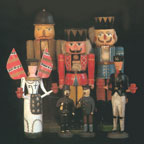
Erzgebirge Wooden Folk Art

The Erzgebirge is a low mountain range just north of the Czech Republic border in the German Province of Saxony, south of Dresden. Although originally known as a mining center ("Erzgebirge" means "ore mountain"), the mountains have always been covered by abundant forests.
Beginning in the early 14th century, mining of silver, tin, iron and nickel fueled the area's economy. By the late 17th century, making wooden wares for household use became a second significant source of employment.
In response to the growing demand for toys in the 18th century, more and more woodworkers became toymakers. When the mines began to play out around the middle of the next century, the miners turned to the cottage industry of woodworking to support their families.
The village of Seiffen, situated in a valley surrounded by forested hills, is the present day center of the traditional Ergebirge wooden folk art. There are about 200 full-time woodworkers in the region and perhaps 800 part-timers, mostly working in small year-round workshops and family enterprises.
Many of the workshops represent generations of the same family, working in the same surroundings, to preserve the heritage of wooden toys and folk art designed by their ancestors more than a century ago.

The forests of the Erzgebirge

Early Erzgebirge Wooden Folk Art (The original Wilhelm Friedrich Füchtner nutcracker is in the center.)
